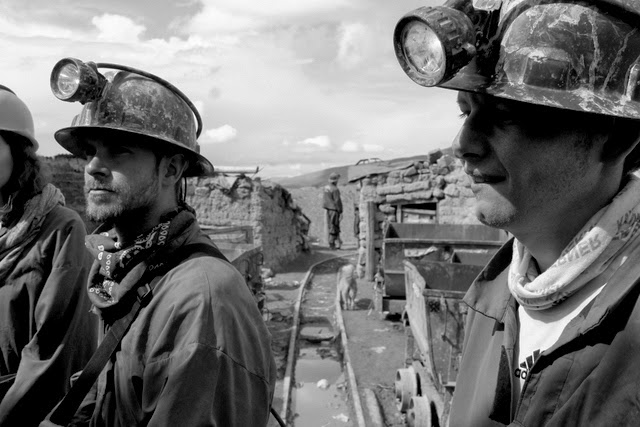Potosi, the historic mining town of Bolivia, South America, and the world, sits at around four kilometres above sea level in between Sucre and the famous salt flats of Uyuni. Potosi saw a boom in growth, wealth, and prosperity during the 16th century when Silver (among other minerals) was discovered in the mountain looming over the town's edge. Upon this discovery, the Spanish throne ordered the immediate and complete exploitation of this mountain for every last silver coin that it may hold. The mining is still going to this day in Potosi, although to a much lesser extent and with nationalized coops running the operations.
It is said that upon the boom era of the 1540's, Potosi grew to one of the largest and richest cities in the world, with a population topping 200,000 (fairly large for that day in age). Unfortunately, the boom that placed the city on the map did not leave much behind except some beautiful architecture and a sizable scar on the lives of local Potosinos. It is estimated that since the discovery of silver in Cerro Rico and the beginning of its extraction, some 8 million Bolivians have died (in addition to numerous African slaves shipped over to help fuel the efforts).
 Today there are several tours offered that take you inside the mines and teach you about the history and the refining process of silver. Our tour guide was quite the show, and he had a lot of enthusiasm to keep us on our toes as well. In addition to poking constant jokes and keeping us engaged the entire four hours of the tour, he went as far as passing real sticks of dynamite around for us to fondle, explaining how fuses and nitroglycerin work. He then lodged a dynamite stick in the German girls' shirt, holding the match to the fuse to show that it will only ignite in certain spots.... Aha!, I love tours in Bolivia - there's a reason why the souvenir shirt always reads: "I survived ____in ____, Bolivia"
Today there are several tours offered that take you inside the mines and teach you about the history and the refining process of silver. Our tour guide was quite the show, and he had a lot of enthusiasm to keep us on our toes as well. In addition to poking constant jokes and keeping us engaged the entire four hours of the tour, he went as far as passing real sticks of dynamite around for us to fondle, explaining how fuses and nitroglycerin work. He then lodged a dynamite stick in the German girls' shirt, holding the match to the fuse to show that it will only ignite in certain spots.... Aha!, I love tours in Bolivia - there's a reason why the souvenir shirt always reads: "I survived ____in ____, Bolivia"
After we had gotten out of the dynamite house with some gifts of: dynamite(of course), bottled water, and coca leaves for the miners (and our lives), we were shown where they processed the silver in a facility located right in Potosi. This part was interesting, but the real highlight of the tour was saved for last: one and a half hours navigating the dark and winding mine shafts of Cerro Rico. To be quite honest, this scared me a bit more than the death road tour outside of La Paz did. Although the biking implied the chance of plummeting a kilometre down a steep cliff to your unpredictable demise, in the mines we had: absolutely no control of our fate, had no idea where we were going, could barely see anything, were pressed into tight tunnels - at times nearly crawling as the ceiling came down to a mere three feet of passage, and this all while struggling to steal our gasps of oxygen through the gaseous fumes of the minerals and their extraction. We had bandanas covering our nose to help with the heavy airborne particles, but this didn't help much to fend off the fumes we could not entirely escape. There is no ventilation system or assisted breathing mechanisms and the only safety measure that has finally come into effect in the mines is the wearing of helmets (and only recently to my understanding).
Additional risk factors leading to the high death toll in the mines of Potosi are tied to culture. The culture to drink heavily means that many workers come to work either drunk or hungover in the morning, and then head into the mines for 8 hours with nothing more than some coca leaves and possibly some more hard alcohol. It is also custom to bring offerings of alcohol and coca leaves to gift to El Tio (the uncle), a devilish looking relic/idol sitting inside one of the mine shafts. The beliefs state that he will keep the miners safe and protect their silver if they leave offerings for him. To me this sounds like a deal with the devil, yet unfortunately this was a last resort to many, with a highly superstitious culture and no other options for employment.
The tour was a very moving experience and shed light on yet another heavy topic of the trials and tribulations that the indigenous people of South America have suffered throughout history. What is sad is that the mining continues to this very day, as the economy has literally placed all of its eggs in one basket. This means there are few other career options for local Potosinos to enter unless they manage to educate themselves and flee to the surrounding regions of Bolivia. Furthermore, the limited safety measures and culture to drink on the job have not changed. It is at least this point that could be addressed in my opinion, maybe reducing the steady death toll that the mountain that eats men continues to claim.
Mines of Potosi - The Video




No comments:
Post a Comment